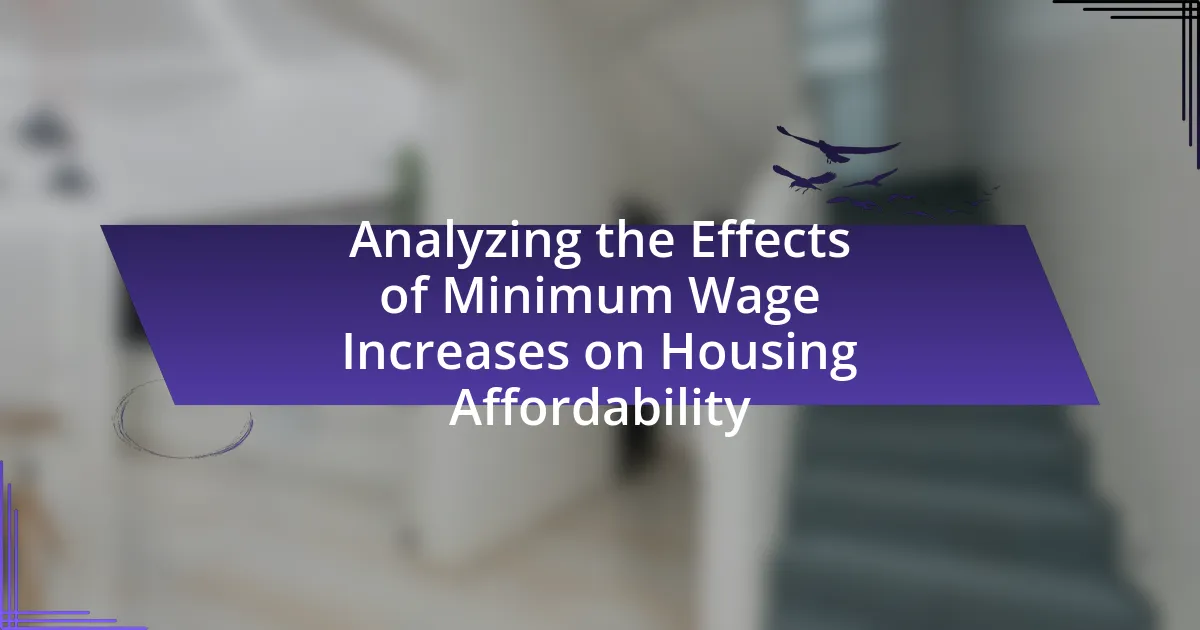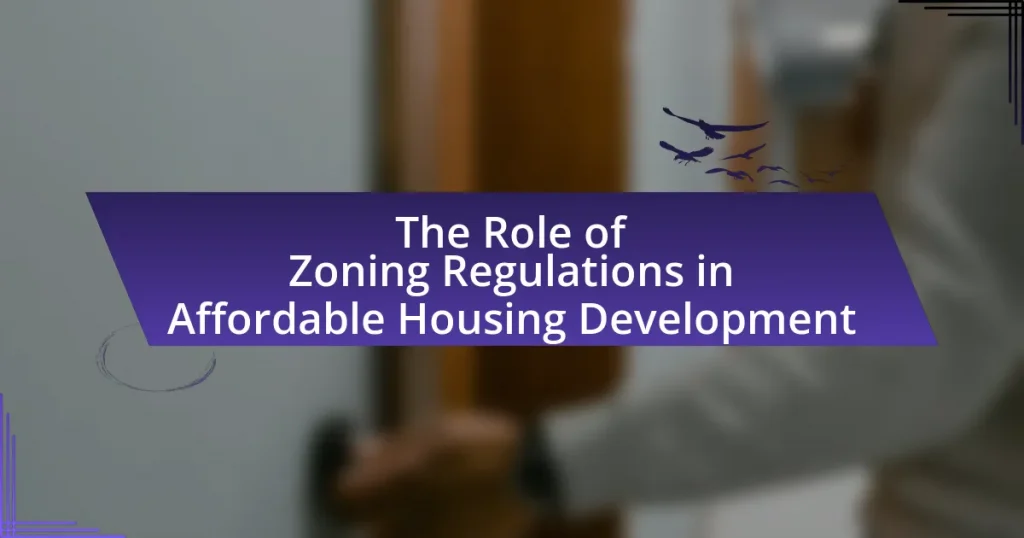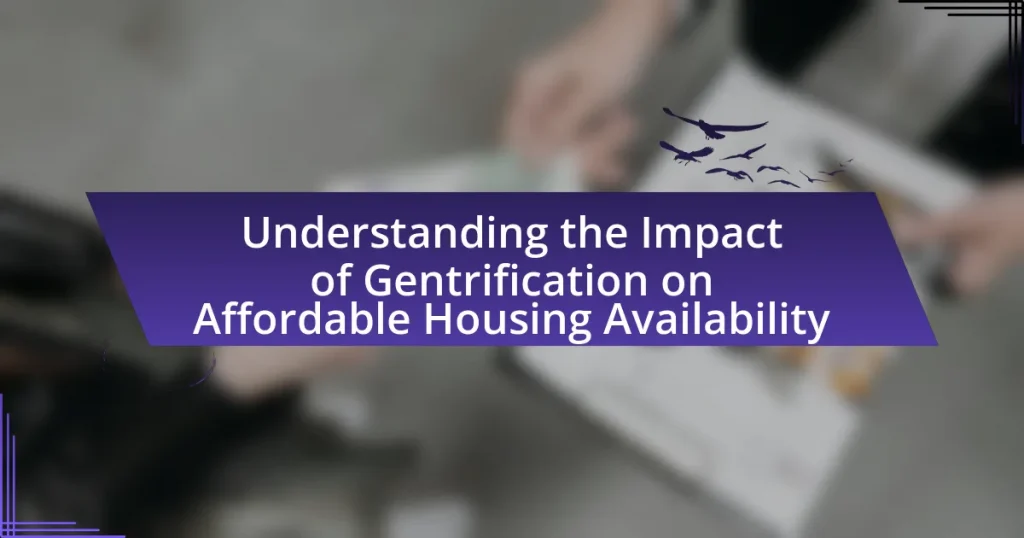The article analyzes the effects of minimum wage increases on housing affordability, highlighting the relationship between wage growth and housing costs. It discusses how higher minimum wages can improve housing affordability for low-income workers by increasing disposable income, which allows for a greater allocation towards housing expenses. The article also examines the broader economic impacts of wage increases, including consumer spending and inflation, while addressing the potential for rising housing costs due to increased demand. Additionally, it explores demographic groups most affected by housing affordability issues and suggests strategies for policymakers to balance wage increases with housing accessibility.
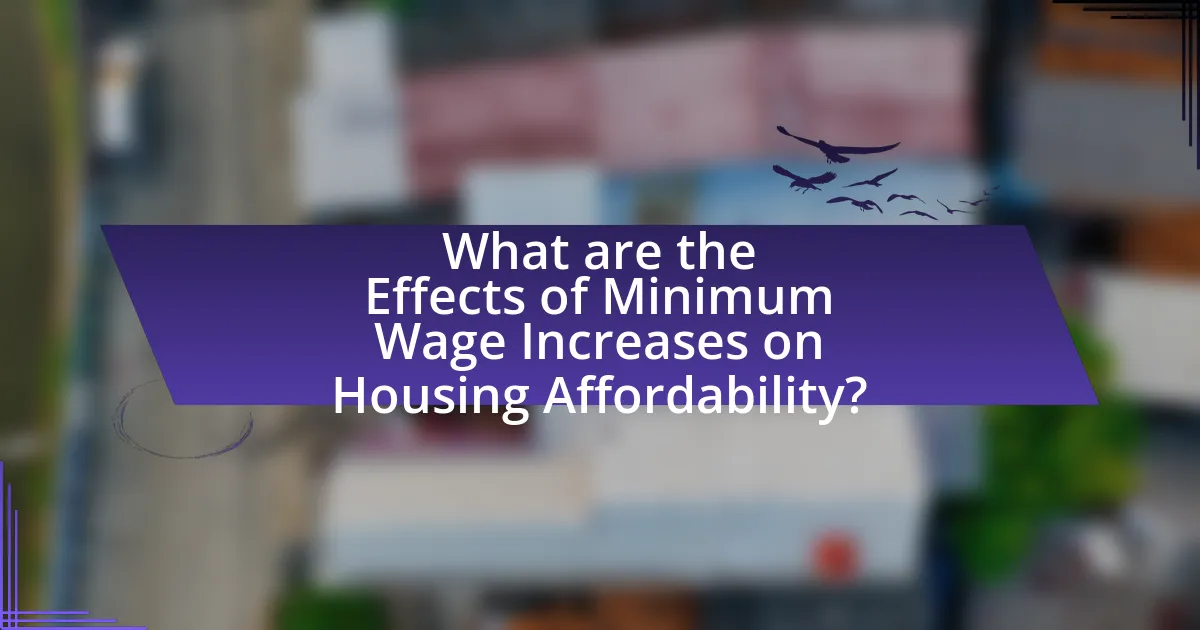
What are the Effects of Minimum Wage Increases on Housing Affordability?
Minimum wage increases generally lead to improved housing affordability for low-income workers by increasing their disposable income. As wages rise, workers have more financial resources to allocate towards housing costs, which can reduce the percentage of income spent on rent or mortgage payments. For instance, a study by the National Low Income Housing Coalition found that in areas where minimum wage was increased, there was a corresponding decrease in the rent burden for low-income households, as they could afford a greater share of housing costs. Additionally, higher minimum wages can stimulate local economies, potentially leading to increased housing supply and more affordable options.
How do minimum wage increases impact the overall economy?
Minimum wage increases generally stimulate the overall economy by boosting consumer spending. When workers receive higher wages, they have more disposable income, which leads to increased demand for goods and services. For instance, a study by the Economic Policy Institute found that a $15 minimum wage could increase the earnings of 41 million workers, resulting in an estimated $118 billion in additional consumer spending. This heightened demand can drive business growth and potentially lead to job creation. Additionally, higher wages can reduce employee turnover and increase productivity, further benefiting the economy.
What are the direct effects of increased wages on consumer spending?
Increased wages directly lead to higher consumer spending as individuals have more disposable income. This increase in disposable income allows consumers to purchase more goods and services, thereby stimulating demand in the economy. For instance, a study by the Economic Policy Institute found that a 10% increase in the minimum wage can lead to a 2-3% increase in consumer spending among low-wage workers. This heightened spending can contribute to economic growth and can also positively impact businesses by increasing sales and potentially leading to job creation.
How do wage increases influence inflation rates?
Wage increases generally lead to higher inflation rates due to increased consumer spending power. When wages rise, workers have more disposable income, which can boost demand for goods and services. This heightened demand can result in businesses raising prices to match the increased consumption, thereby contributing to inflation. Historical data from the U.S. Bureau of Labor Statistics indicates that periods of significant wage growth often correlate with rising inflation rates, as seen in the late 1970s when wage increases contributed to double-digit inflation.
What is the relationship between minimum wage and housing costs?
The relationship between minimum wage and housing costs is that increases in minimum wage can lead to higher housing costs. When minimum wage rises, it often results in increased disposable income for workers, which can drive demand for housing. This heightened demand can lead landlords to raise rents, thereby increasing housing costs. For instance, a study by the National Low Income Housing Coalition found that in areas where minimum wage increases were implemented, rental prices tended to rise, making housing less affordable for low-income workers.
How do wage increases affect rental prices?
Wage increases typically lead to higher rental prices due to increased demand for housing. When wages rise, individuals have more disposable income, which often results in a greater willingness to pay for rent. This increased demand can drive up rental prices, particularly in areas with limited housing supply. For instance, a study by the National Bureau of Economic Research found that a 10% increase in the minimum wage can lead to a 1-2% increase in rental prices in urban areas, highlighting the direct correlation between wage growth and housing costs.
What trends can be observed in housing affordability following wage hikes?
Housing affordability generally improves following wage hikes, as increased income allows households to allocate more funds toward housing costs. For instance, studies indicate that when minimum wages rise, the percentage of income spent on housing often decreases, leading to a more favorable affordability index. According to the National Low Income Housing Coalition, in areas where minimum wage increases have been implemented, there has been a notable reduction in the number of households experiencing severe housing cost burdens, defined as spending more than 50% of their income on housing. This trend suggests that wage hikes can enhance the financial capacity of workers to afford housing, thereby positively impacting overall housing affordability.
Why is housing affordability a critical issue in relation to minimum wage?
Housing affordability is a critical issue in relation to minimum wage because many workers earning minimum wage struggle to find housing that does not exceed 30% of their income, which is the standard benchmark for affordability. For instance, in 2021, the National Low Income Housing Coalition reported that a full-time minimum wage worker could afford only a modest rental unit in just 7% of U.S. counties, highlighting the disparity between wages and housing costs. This gap leads to increased financial strain, forcing individuals to allocate a disproportionate amount of their income to housing, which can result in homelessness or unstable living conditions.
What demographic groups are most affected by housing affordability issues?
Low-income households, particularly renters, are the demographic groups most affected by housing affordability issues. According to the Joint Center for Housing Studies of Harvard University, nearly 50% of renters in the bottom income quintile spend more than 30% of their income on housing, which is considered a burden. Additionally, single-parent families, particularly those led by women, face significant challenges, as they often have lower incomes and higher housing costs relative to their earnings. Furthermore, communities of color, especially Black and Hispanic households, experience higher rates of housing cost burdens due to systemic inequalities in income and wealth accumulation.
How does housing affordability impact social mobility?
Housing affordability significantly impacts social mobility by determining individuals’ access to quality education, employment opportunities, and overall economic stability. When housing costs consume a large portion of income, families often have limited resources for essential services such as education and healthcare, which are critical for upward mobility. Research indicates that high housing costs correlate with lower rates of social mobility; for instance, a study by the National Bureau of Economic Research found that children from low-income families are less likely to move up the income ladder in areas with high housing costs. Thus, affordable housing is essential for fostering an environment where individuals can improve their socio-economic status.
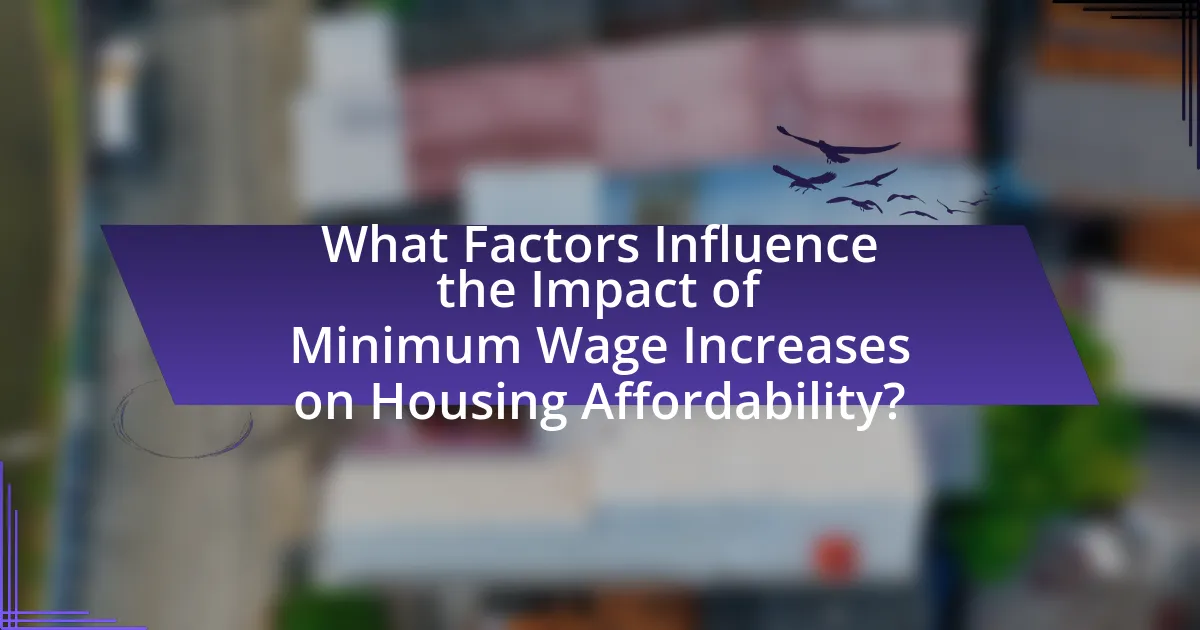
What Factors Influence the Impact of Minimum Wage Increases on Housing Affordability?
The impact of minimum wage increases on housing affordability is influenced by several key factors, including local housing market conditions, the elasticity of housing supply, and the overall economic environment. Local housing market conditions, such as demand and supply dynamics, determine how much housing prices can adjust in response to wage changes. For instance, in areas with high demand and limited supply, minimum wage increases may lead to higher rents, exacerbating affordability issues. The elasticity of housing supply refers to how quickly and effectively the housing market can respond to increased demand; inelastic supply can lead to significant price increases. Additionally, the overall economic environment, including inflation rates and employment levels, affects disposable income and housing costs. Research indicates that in regions where minimum wage increases are substantial, housing costs often rise, impacting affordability negatively, particularly for low-income households.
How do regional differences affect the relationship between minimum wage and housing costs?
Regional differences significantly influence the relationship between minimum wage and housing costs, as variations in local economies, cost of living, and housing markets create distinct dynamics. For instance, in urban areas with high demand for housing, such as San Francisco, the minimum wage may not keep pace with skyrocketing housing costs, leading to affordability issues. Conversely, in rural areas where housing is more affordable, a lower minimum wage may still allow residents to secure adequate housing. According to a report by the National Low Income Housing Coalition, in 2021, a worker would need to earn $36.13 per hour to afford a two-bedroom rental in San Francisco, highlighting the disparity between minimum wage and housing costs in high-demand regions. This illustrates how regional economic conditions shape the effectiveness of minimum wage policies in addressing housing affordability.
What role does local economic development play in housing affordability?
Local economic development significantly influences housing affordability by creating jobs and increasing income levels within a community. When local economies grow, they often attract businesses, leading to job creation and higher wages, which can enhance residents’ purchasing power for housing. For instance, a study by the National Association of Home Builders found that a 10% increase in local employment can lead to a 5% increase in housing prices due to heightened demand. Additionally, local economic development initiatives can improve infrastructure and services, making areas more desirable and further driving up housing costs. Thus, the relationship between local economic development and housing affordability is characterized by a direct correlation between economic growth, income levels, and housing demand.
How do housing supply and demand dynamics interact with wage increases?
Housing supply and demand dynamics are significantly influenced by wage increases, as higher wages generally lead to increased demand for housing. When wages rise, individuals have more disposable income, which can drive up demand for housing, particularly in areas where employment opportunities are concentrated. This increased demand can lead to higher housing prices if the supply of housing does not keep pace. For instance, a study by the National Bureau of Economic Research found that a 10% increase in the minimum wage can lead to a 1.5% increase in housing prices in urban areas, illustrating the direct correlation between wage increases and housing demand. Conversely, if housing supply is elastic and can adjust to the increased demand, the impact on prices may be mitigated, allowing for better housing affordability despite wage increases.
What are the potential long-term effects of minimum wage increases on housing markets?
Minimum wage increases can lead to higher housing demand and prices in the long term. As workers earn more, their purchasing power increases, allowing them to afford better housing options. This increased demand can drive up rental prices and home values, particularly in areas with limited housing supply. For instance, a study by the National Bureau of Economic Research found that a 10% increase in the minimum wage can lead to a 1-3% increase in housing prices over time, reflecting the correlation between wage growth and housing market dynamics.
How might sustained wage increases alter housing market trends?
Sustained wage increases can lead to higher demand for housing, subsequently driving up property prices and rental rates. As individuals experience increased disposable income, their ability to afford housing improves, which can result in more competition for available properties. This heightened demand often leads to a rise in home prices; for instance, a study by the National Bureau of Economic Research found that a 10% increase in wages can correlate with a 1.5% increase in housing prices. Additionally, as wages rise, developers may respond by increasing the supply of housing to meet the growing demand, potentially leading to a shift in market dynamics.
What implications do these changes have for future housing policies?
The changes resulting from minimum wage increases will likely necessitate a reevaluation of future housing policies to ensure affordability for low-income workers. As minimum wage rises, housing demand may increase, leading to potential price hikes in rental markets. For instance, a study by the National Low Income Housing Coalition indicates that in areas where minimum wage increases have been implemented, there is often a corresponding rise in housing costs, which can outpace wage growth. Consequently, housing policies may need to incorporate measures such as increased funding for affordable housing development, rent control mechanisms, and enhanced support for housing vouchers to mitigate the risk of displacement and ensure that housing remains accessible to low-income populations.
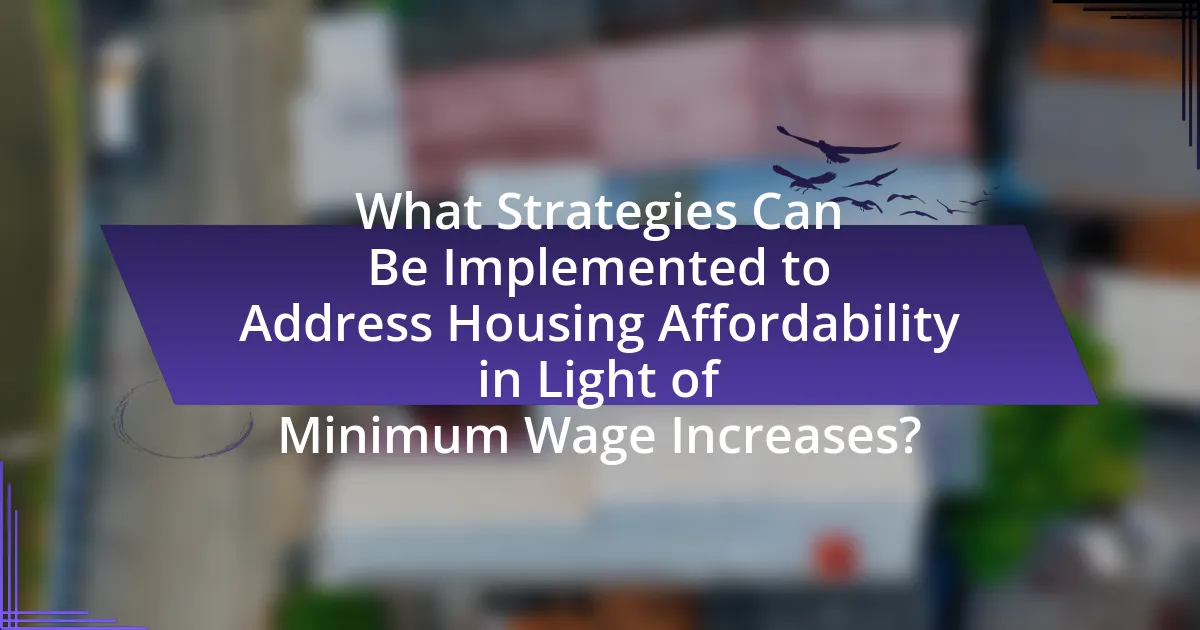
What Strategies Can Be Implemented to Address Housing Affordability in Light of Minimum Wage Increases?
To address housing affordability in light of minimum wage increases, strategies such as increasing the supply of affordable housing, implementing rent control measures, and providing housing vouchers can be effective. Increasing the supply of affordable housing can be achieved through zoning reforms and incentives for developers to build low-income units, which can help meet the demand created by higher wages. Rent control measures can stabilize housing costs for low-income renters, preventing displacement as wages rise. Additionally, housing vouchers can assist low-income families in affording rent in the private market, directly linking assistance to housing costs. These strategies are supported by studies indicating that increased housing supply and targeted financial assistance can mitigate the impact of wage increases on housing affordability.
How can policymakers balance minimum wage increases with housing affordability?
Policymakers can balance minimum wage increases with housing affordability by implementing targeted housing policies alongside wage adjustments. For instance, increasing the minimum wage can enhance workers’ purchasing power, but without corresponding housing policies, it may lead to higher rents as landlords adjust to increased income levels. Evidence from studies, such as the National Low Income Housing Coalition’s “Out of Reach” report, indicates that in many regions, minimum wage earners cannot afford market-rate housing, highlighting the need for affordable housing initiatives. By coupling minimum wage increases with investments in affordable housing, rent control measures, and housing subsidies, policymakers can mitigate the risk of exacerbating housing affordability issues while supporting low-income workers.
What role do housing subsidies play in mitigating affordability issues?
Housing subsidies play a crucial role in mitigating affordability issues by providing financial assistance to low-income households, enabling them to access housing that would otherwise be unaffordable. These subsidies reduce the rent burden on families, allowing them to allocate a larger portion of their income to other essential needs such as food, healthcare, and education. For instance, the U.S. Department of Housing and Urban Development reported that housing vouchers can reduce rent payments by an average of 70%, significantly improving housing stability and quality of life for recipients. Additionally, studies have shown that areas with robust housing subsidy programs experience lower rates of homelessness and improved economic mobility, demonstrating the effectiveness of these interventions in addressing affordability challenges.
How can zoning laws be adjusted to improve housing availability?
Zoning laws can be adjusted to improve housing availability by increasing density allowances, allowing mixed-use developments, and reducing minimum lot sizes. Increasing density allows for more housing units in a given area, which can alleviate shortages. For example, cities like Minneapolis have eliminated single-family zoning, enabling the construction of duplexes and triplexes, which has led to a significant increase in housing options. Allowing mixed-use developments encourages the integration of residential and commercial spaces, fostering vibrant communities and reducing the need for extensive commuting. Additionally, reducing minimum lot sizes can facilitate the construction of smaller, more affordable housing units, addressing the needs of low-income residents. These adjustments have been shown to enhance housing supply and affordability in various urban settings.
What best practices can be adopted by communities to enhance housing affordability?
Communities can enhance housing affordability by implementing inclusionary zoning policies that require a percentage of new developments to be affordable for low- and moderate-income households. This practice has been shown to increase the availability of affordable housing units; for example, cities like San Francisco and New York have successfully integrated such policies, resulting in thousands of affordable units being created. Additionally, communities can invest in public-private partnerships to leverage funding for affordable housing projects, as seen in various successful initiatives across the United States, which have led to significant reductions in housing costs for residents. Furthermore, streamlining permitting processes can reduce construction costs and time, thereby making housing more affordable; studies indicate that reducing bureaucratic delays can lower overall project costs by up to 20%.
How can community organizations support affordable housing initiatives?
Community organizations can support affordable housing initiatives by advocating for policy changes, providing resources, and facilitating community engagement. These organizations often mobilize local residents to influence legislation that promotes affordable housing development, such as zoning reforms or funding allocations. For instance, studies have shown that community-led advocacy can lead to increased funding for affordable housing projects, as seen in cities like San Francisco, where local organizations successfully lobbied for the creation of a housing trust fund. Additionally, community organizations can offer educational programs that inform residents about their rights and available housing resources, thereby empowering them to seek affordable options.
What innovative housing solutions can be explored to address affordability challenges?
Innovative housing solutions to address affordability challenges include the development of modular housing, community land trusts, and co-housing models. Modular housing, which involves prefabricated units, can significantly reduce construction costs and time, making homes more affordable. Community land trusts allow communities to own land collectively, ensuring long-term affordability by removing land from the speculative market. Co-housing models promote shared resources and communal living, reducing individual housing costs while fostering community engagement. These solutions have been supported by studies indicating that such approaches can effectively lower housing expenses and improve access to affordable housing options.
What are the key takeaways for individuals regarding minimum wage and housing affordability?
Key takeaways for individuals regarding minimum wage and housing affordability include the understanding that increases in minimum wage can lead to improved housing affordability for low-income workers. Research indicates that when minimum wage rises, workers often experience a boost in disposable income, which can alleviate some financial pressure related to housing costs. For instance, a study by the Economic Policy Institute found that a $15 minimum wage could significantly reduce the percentage of income spent on housing for low-wage earners, making housing more accessible. However, it is also crucial to recognize that if housing costs rise faster than wage increases, the intended benefits may be undermined, leading to continued affordability challenges.
